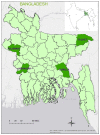Primary healthcare system readiness to prevent and manage non-communicable diseases in Bangladesh: a mixed-method study protocol
- PMID: 34493524
- PMCID: PMC8424828
- DOI: 10.1136/bmjopen-2021-051961
Primary healthcare system readiness to prevent and manage non-communicable diseases in Bangladesh: a mixed-method study protocol
Abstract
Introduction: The burden of non-communicable diseases (NCDs) is rapidly increasing in Bangladesh. Currently, it contributes to 67% of annual deaths, and accounts for approximately 64% of the disease burden. Since 70% of the Bangladeshi population residing in the rural area rely on the primary healthcare system, assessment of its capacity is crucial for guiding public health decisions to prevent and manage NCDs. This protocol is designed to recognise and assess the Bangladeshi health system's readiness for NCDs at the primary level.
Methods and analysis: The study will use a mixed-method design. Numerical data will be collected using households and health facilities surveys, while qualitative data will be collected by interviewing healthcare providers, policy planners, health administrators and community members. The WHO's Service Availability and Readiness Assessment (SARA) methodology and Package of Essential Non-communicable (PEN) Disease Interventions for Primary Healthcare reference manuals will be used to assess the readiness of the primary healthcare facilities for NCD services. Furthermore, Health System Dynamics Framework will be used to examine health system factors. Using the supportive items outlined in the WHO PEN package, and indicators proposed in WHO SARA methodology, a composite score will be created to analyse facility-level data. Two independent samples t-test, analysis of variance and χ2 test methods will be used for bivariate analysis, and multiple regression analysis will be used for multivariable analysis. Complementarily, the thematic analysis approach will be used to analyse qualitative data.
Ethics and dissemination: The project has been approved by the Monash University Human Research Ethics Committee (Project ID: 27112), and Bangladesh Medical Research Council (Ref: BMRC/NREC/2019-2022/270). The research findings will be shared through research articles, conference proceedings or in other scientific media. The reports or publications will not have any information that can be used to identify any of the study participants.
Keywords: human resource management; organisation of health services; public health; qualitative research; quality in health care.
© Author(s) (or their employer(s)) 2021. Re-use permitted under CC BY-NC. No commercial re-use. See rights and permissions. Published by BMJ.
Conflict of interest statement
Competing interests: None declared.
Figures





Similar articles
-
The capacity of primary healthcare facilities in Bangladesh to prevent and control non-communicable diseases.BMC Prim Care. 2023 Mar 2;24(1):60. doi: 10.1186/s12875-023-02016-6. BMC Prim Care. 2023. PMID: 36864391 Free PMC article.
-
Non-communicable disease (NCD) corners in public sector health facilities in Bangladesh: a qualitative study assessing challenges and opportunities for improving NCD services at the primary healthcare level.BMJ Open. 2019 Oct 7;9(10):e029562. doi: 10.1136/bmjopen-2019-029562. BMJ Open. 2019. PMID: 31594874 Free PMC article.
-
Health facility readiness to provide antenatal care (ANC) and non-communicable disease (NCD) services in Nepal and Bangladesh: Analysis of facility-based surveys.PLoS One. 2023 Mar 13;18(3):e0281357. doi: 10.1371/journal.pone.0281357. eCollection 2023. PLoS One. 2023. PMID: 36913361 Free PMC article.
-
Health system readiness for non-communicable diseases at the primary care level: a systematic review.BMJ Open. 2022 Feb 9;12(2):e060387. doi: 10.1136/bmjopen-2021-060387. BMJ Open. 2022. PMID: 35140165 Free PMC article.
-
Addressing Non-Communicable Diseases in Primary Healthcare in Kyrgyzstan: A Study on Population' Knowledge and Behavioral Changes.Int J Public Health. 2023 Jul 4;68:1605381. doi: 10.3389/ijph.2023.1605381. eCollection 2023. Int J Public Health. 2023. PMID: 37469755 Free PMC article. Review.
Cited by
-
Challenges and Strategies in Conducting Population Health Research during the COVID-19 Pandemic: Experience from a Nationwide Mixed-Methods Study in Bangladesh.Int J Environ Res Public Health. 2023 Apr 25;20(9):5629. doi: 10.3390/ijerph20095629. Int J Environ Res Public Health. 2023. PMID: 37174149 Free PMC article.
-
A Readiness Level Assessment of Healthcare Facilities in the Democratic Republic of Congo for the Management of Cardiovascular Disease and Diabetes.J Clin Med. 2025 May 16;14(10):3498. doi: 10.3390/jcm14103498. J Clin Med. 2025. PMID: 40429492 Free PMC article.
-
Assessing service availability and readiness of healthcare facilities to manage diabetes mellitus in Bangladesh: Findings from a nationwide survey.PLoS One. 2022 Feb 16;17(2):e0263259. doi: 10.1371/journal.pone.0263259. eCollection 2022. PLoS One. 2022. PMID: 35171912 Free PMC article.
-
Primary health care as the main guarantor of a healthy population in the country and a global challenge in the world: a systematic review.F1000Res. 2024 Oct 10;13:38. doi: 10.12688/f1000research.141252.2. eCollection 2024. F1000Res. 2024. PMID: 40626093 Free PMC article.
-
Self-reported health complaints and healthcare-seeking behaviour among adult people in rural Bangladesh: results from a cross-sectional study.BMJ Open. 2025 Feb 8;15(2):e086324. doi: 10.1136/bmjopen-2024-086324. BMJ Open. 2025. PMID: 39922595 Free PMC article.
References
-
- World Health Organization . Noncommunicable diseases: key facts: WHO, 2018. Available: https://www.who.int/news-room/fact-sheets/detail/noncommunicable-diseases
-
- World Health Organization . Global status report on noncommunicable diseases 2010: WHO, 2010. Available: https://www.who.int/nmh/publications/ncd_report2010/en/
-
- Habib SH, Saha S. Burden of non-communicable disease: global overview. Diabetes Metab Syndr 2010;4:41–7. 10.1016/j.dsx.2008.04.005 - DOI
MeSH terms
LinkOut - more resources
Full Text Sources
